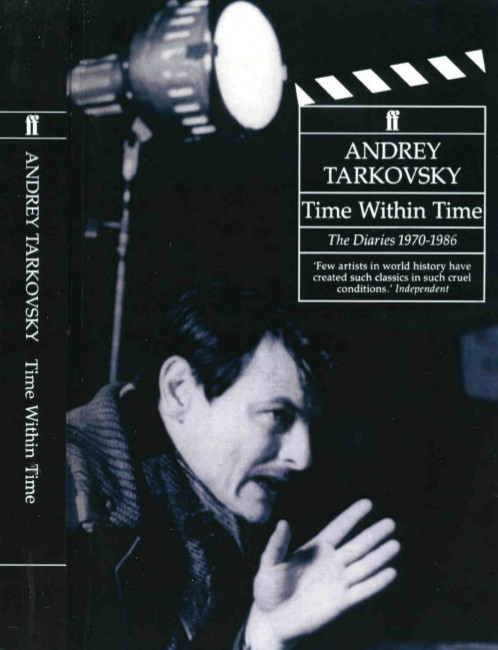Andrey Tarkovsky: Time Within Time: The Diaries 1970-1986 (1994)
Filed under book | Tags: · cinema, film, film theory

“The diaries of the Russian filmmaker Andrei Tarkovsky cover his life and work in the Soviet Union and the time of his exile in Western Europe.
He called his diaries Martyrolog about which he said in 1974: ‘Pretentious and false as a title, but let it stay as a reminder of my ineradicable, futile worthlessness.’ The diaries are deeply personal and were intended mainly for Tarkovsky himself. Some entries are seemingly trivial, as for example shopping lists or entries on his health. Another frequent topic are other film directors or artists, which Tarkovsky generally regarded with a negative attitude. At other time Tarkovsky discusses philosophical or film theoretical questions, not necessarily related to day to day events. Tarkovsky kept his diary until shortly before his death on December 29, 1986. The last entry was on December 15, 1986. His last words were ‘But now I have no strength left – that is the problem’.
After the 1991 coup several memos surfaced that alleged that the KGB had at times access to the diaries. Although Tarkovsky did not openly oppose the Soviet system, his work heavily emphasized spiritual themes, that were at conflict with the official anti-religious atheist ideology, prompting the KGB to open a file on him.” (Wikipedia)
First published in German, Verlag Ullstein, Frankfurt am Main/Berlin, 1989
Translated from the Russian by Kitty Hunter-Blair, 1991 (Russian original was not published until 2008)
Publisher Faber and Faber, London/Boston, 1994
ISBN 0571167179, 9780571167173
407 pages
Siegfried Kracauer: The Mass Ornament: Weimar Essays (1963/1995)
Filed under book | Tags: · 1920s, 1930s, cinema, cultural criticism, cultural politics, dance, everyday, film theory, germany, literature, photography, weimar republic

“Siegfried Kracauer was one of the twentieth century’s most brilliant cultural critics, a daring and prolific scholar, and an incisive theorist of film. In this volume his finest writings on modern society make their long-awaited appearance in English.
This book is a celebration of the masses–their tastes, amusements, and everyday lives. Taking up themes of modernity, such as isolation and alienation, urban culture, and the relation between the group and the individual, Kracauer explores a kaleidoscope of topics: shopping arcades, the cinema, bestsellers and their readers, photography, dance, hotel lobbies, Kafka, the Bible, and boredom. For Kracauer, the most revelatory facets of modern life in the West lie on the surface, in the ephemeral and the marginal. Of special fascination to him is the United States, where he eventually settled after fleeing Germany and whose culture he sees as defined almost exclusively by “the ostentatious display of surface.”
With these essays, written in the 1920s and early 1930s and edited by the author in 1963, Kracauer was the first to demonstrate that studying the everyday world of the masses can bring great rewards. The Mass Ornament today remains a refreshing tribute to popular culture, and its impressively interdisciplinary essays continue to shed light not only on Kracauer’s later work but also on the ideas of the Frankfurt School, the genealogy of film theory and cultural studies, Weimar cultural politics, and, not least, the exigencies of intellectual exile.
In his introduction, Thomas Levin situates Kracauer in a turbulent age, illuminates the forces that influenced him–including his friendships with Walter Benjamin, Theodor Adorno, and other Weimar intellectuals–and provides the context necessary for understanding his ideas. Until now, Kracauer has been known primarily for his writings on the cinema. This volume brings us the full scope of his gifts as one of the most wide-ranging and penetrating interpreters of modern life.”
Originally published in German as Das Ornament der Masse: Essays, Suhrkamp Verlag, 1963
Translated, Edited, and with an Introduction by Thomas Y. Levin
Publisher Harvard University Press, 1995
ISBN 0674551621
416 pages
Fredric Jameson: The Geopolitical Aesthetic: Cinema and Space in the World System (1992)
Filed under book | Tags: · aesthetics, capitalism, cinema, film, film theory, narrative, philosophy, politics, postmodern

Taking contemporary films from the United States, Russia, Taiwan, France, and the Philippines, The Geopolitical Aesthetic offers a reading of some of the most interesting films of the last decade and a general account of filmic representation in the postmodern world. Fredric Jameson poses some essential questions: How does representation function in contemporary film? How does contemporary cinema represent an ever more complex and international social reality? Jameson’s sophisticated and theoretically informed readings stress the ways in which disparate films—for example, Godard’s Passion, Pakula’s All the President’s Men, Yang’s The Terrorizer, Tahimik’s The Perfumed Nightmare, Tarkovsky’s Andrei Roublev—confront similar problems of representation. The solutions vary widely but the drive remains the same—the desire to find adequate allegories for our social existence.
The Geopolitical Aesthetic, a refinement and development of the arguments put forward in Jameson’s seminal work The Political Unconscious, is crucial reading for everyone interested in both film analysis and cultural studies.
Publisher Indiana University Press, 1992
Perspectives Series
ISBN 0253330939, 9780253330932
220 pages

